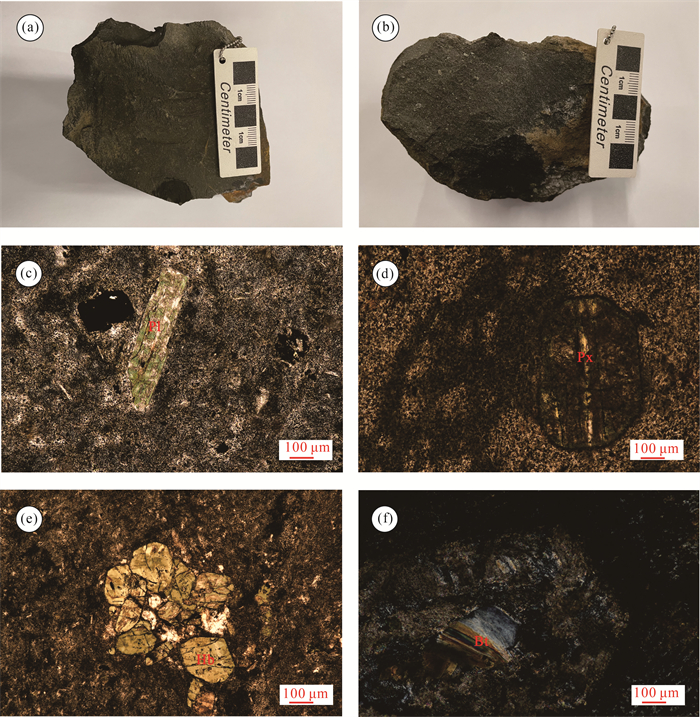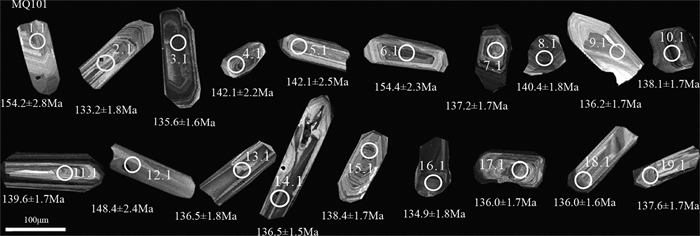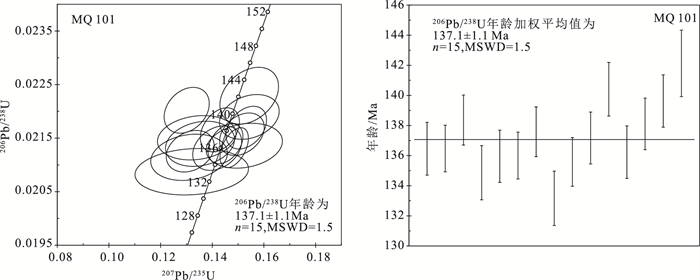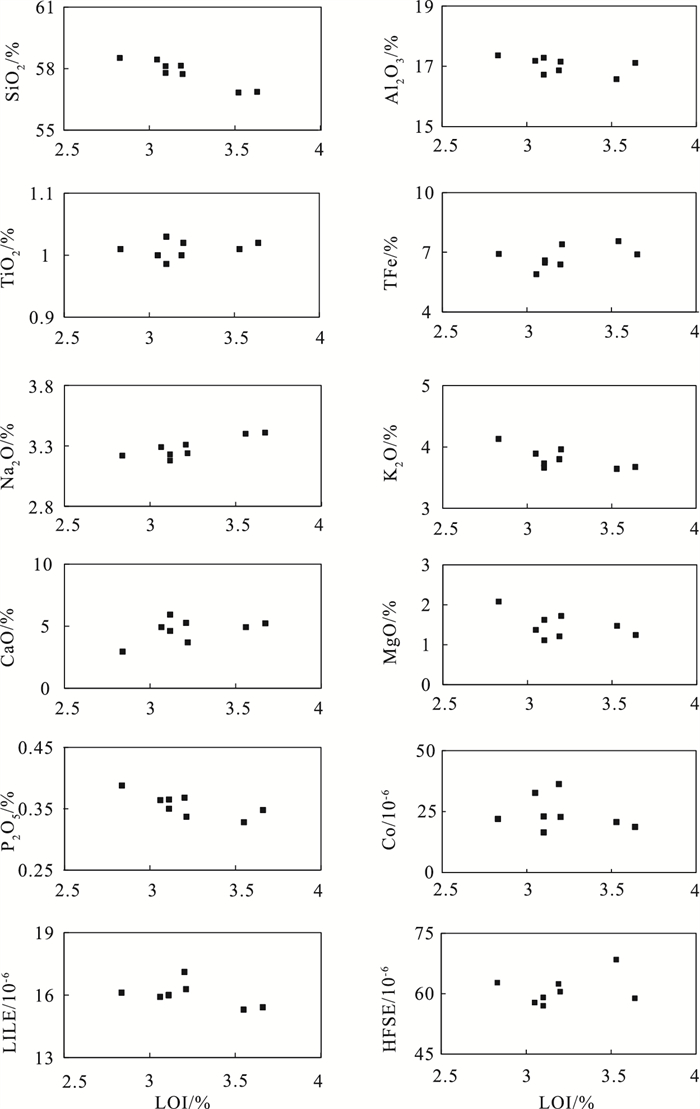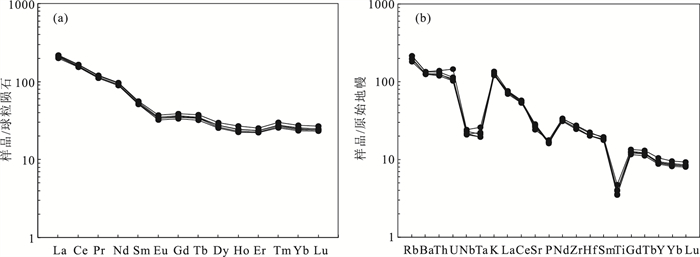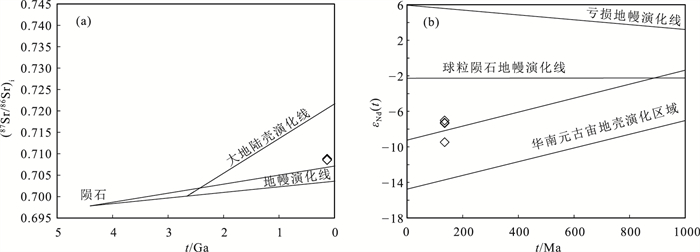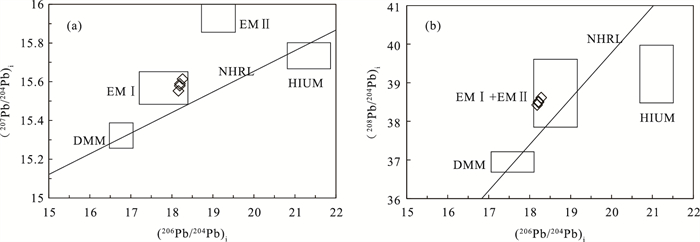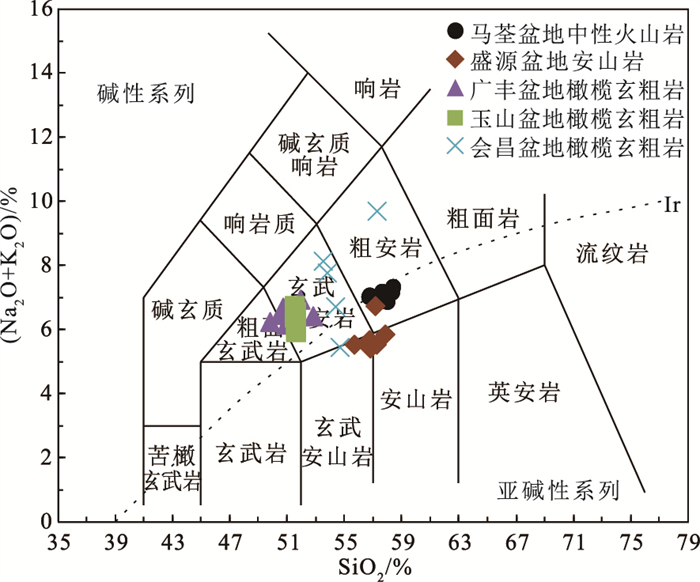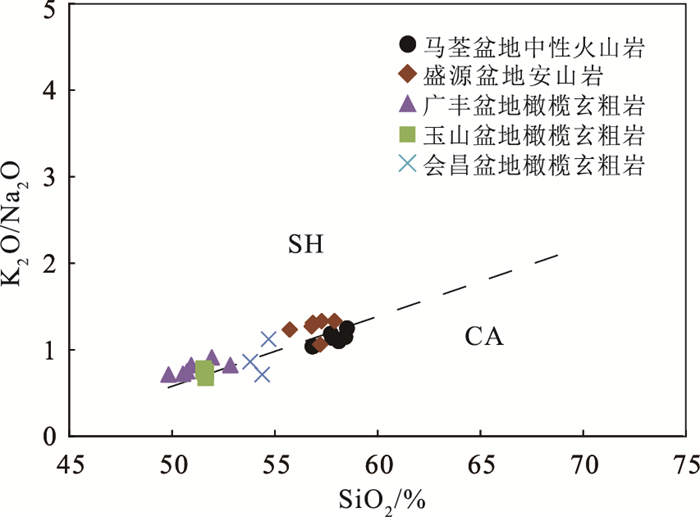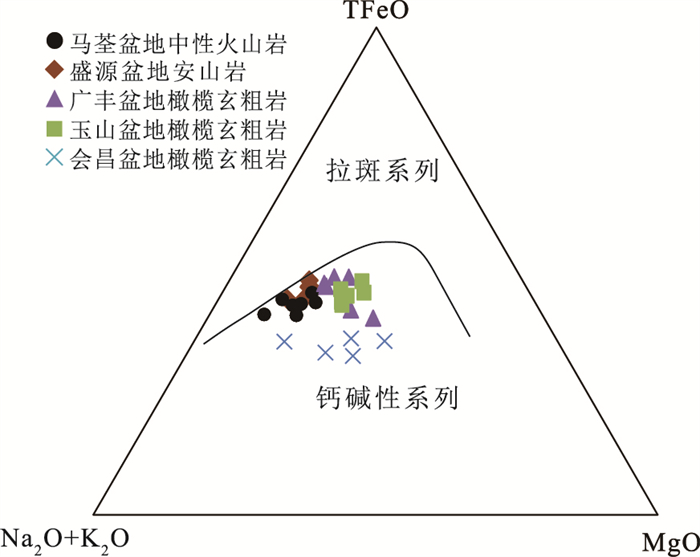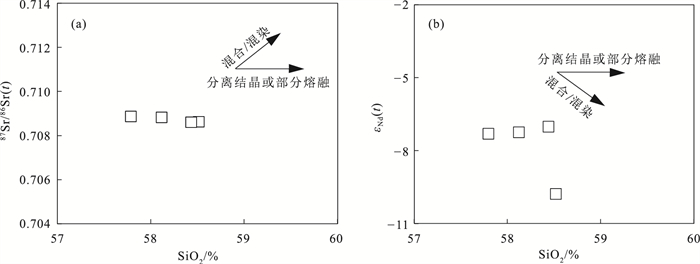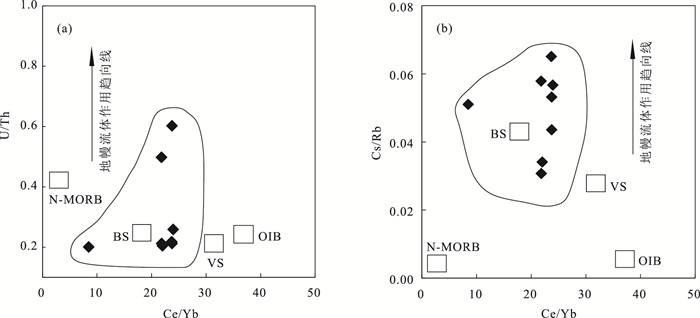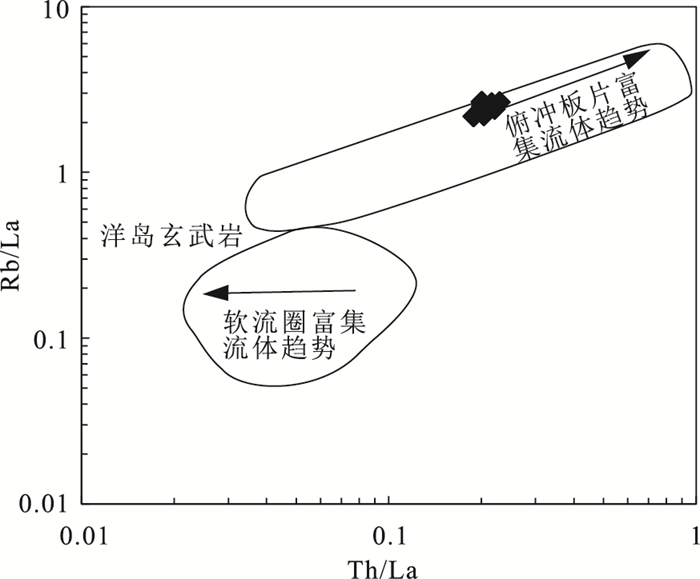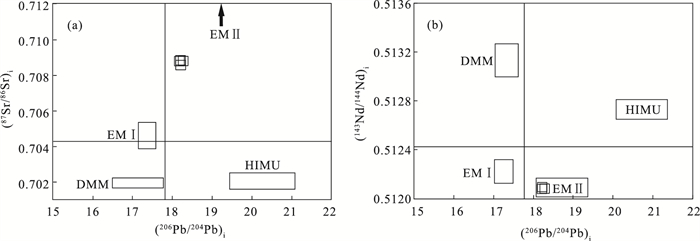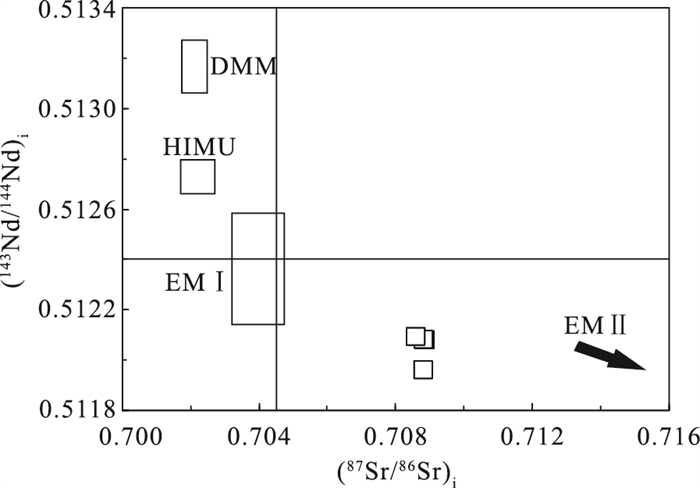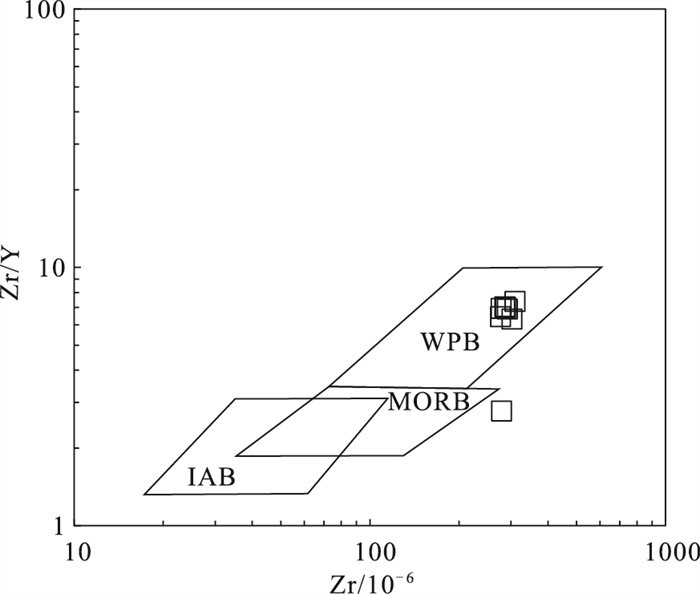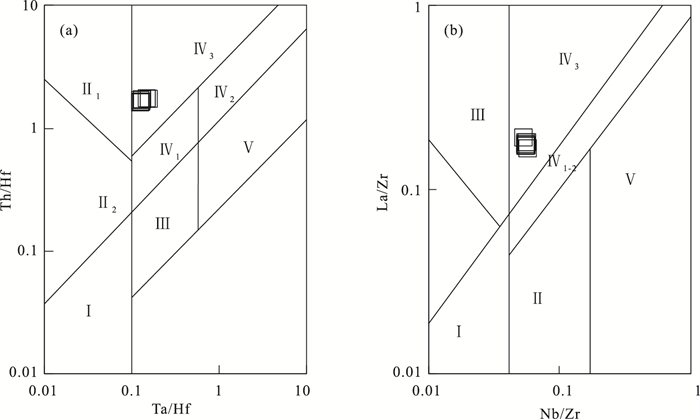Age, geochemical characteristics and petrogenesis of andesites in Maquan basin, Ganhang uranium metallogenic belt
-
摘要:
赣杭铀成矿带位于扬子板块和华夏板块拼接部位, 马荃盆地是该带中段的一个产铀火山盆地, 铀矿体赋存在安山岩中。但其岩石类型、岩石系列归属存在一定争议, 且缺少较精确的岩石年龄。以马荃盆地内中性火山岩为研究对象, 对其进行了年代学、岩石学、地球化学特征研究。研究表明, 火山岩SHRIMP锆石U-Pb年龄为137.1±1.1 Ma(n=15, MSWD=1.5), 为早白垩世早期岩浆活动的产物。马荃盆地中性火山岩呈块状构造, 斑状结构, 以斜长石斑晶为主, 并发育少量辉石、角闪石、黑云母斑晶, 具有富碱、高钾、低铁、贫钛特征, 以及富集轻稀土元素和大离子亲石元素(Rb、Ba、K), 亏损高场强元素(Nb、Ta、Ti)等地球化学特征, 应为安山岩, 属于典型高钾钙碱性系列火山岩。安山岩(87Sr/86Sr)i=0.70855~0.70882, εNd(t)=-9.77~-7.02, (206Pb/204Pb)i=18.17~18.27, (207Pb/204Pb)i=15.56~15.62, (208Pb/204Pb)i=38.43~38.61, (87Sr/86Sr)i-(206Pb/204Pb)i和(143Nd/144Nd)i-(206Pb/204Pb)i及(143Nd/144Nd)i -(87Sr/86Sr)i图解指示, 马荃盆地安山岩源区具有EM Ⅱ型富集地幔的特征。构造环境判别图指示, 马荃盆地安山岩形成于板内伸展环境。综合研究表明, 马荃盆地安山岩是在早白垩世早期拉张构造背景下, 由地幔流体交代形成的EM Ⅱ型富集地幔部分熔融喷出地表的产物。
Abstract:The Ganhang uranium metallogenic belt is located at the junction of the Yangzi plate and the Huaxia plate. The Maquan basin is a uranium-bearing volcanic basin in the middle of this belt, and the uranium ore body is hosted in andesite. However, there is controversy over the rock types and lithological affiliation, and there is a lack of precise rock ages. Therefore, this paper focuses on the study of neutral volcanic rocks in Maquan basin, with the aim of investigating their chronology, petrology, and geochemical characteristics. The results show that the SHRIMP zircon U-Pb age of neutral volcanic rocks is 137.1±1.1 Ma (n=15, MSWD=1.5), which is a product of Early cretaceous magmatism. The neutral volcanic rocks in Maquan basin have a massive and porphyritic texture, with plagioclase as the main phenocryst, and contain a small amount of pyroxene, hornblende, and biotite. They are rich in alkali, high in potassium, low in iron, and poor in titanium, and they are enriched in light rare earth elements and large ion lithophile elements (Rb, Ba, K), but lack high field strength elements (Nb, Ta, Ti). These geochemical characteristics indicate that they are andesites, belonging to the typical high-potassium calc-alkaline volcanic rock series. The andesites have (87Sr/86Sr)i=0.70855~0.70882, εNd(t)=-9.77~-7.02, (206Pb/204Pb)i=18.17~18.27, (207Pb/204Pb)i=15.56~15.62, (208Pb/204Pb)i=38.43~38.61. The (87Sr/86Sr)i-(206Pb/204Pb)i and (143Nd/144Nd)i-(206Pb/204Pb)i as well as (143Nd/144Nd)i-(87Sr/86Sr)i diagrams indicate that the andesite source region in Maquan basin has the characteristics of enriched mantle EM Ⅱ. The tectonic discrimination diagrams indicate that the andesites in Maquan basin were formed in an intraplate extensional environment. The comprehensive study shows that the andesites in Maquan basin were produced by partial melting of enriched mantle EM Ⅱ mobilized by mantle fluids in an early cretaceous extensional tectonic setting.
-
Keywords:
- andesite /
- zircon U-Pb age /
- geochemistry /
- EM Ⅱ enriched mantle /
- Early Cretaceous /
- Maquan basin
-
赣杭铀成矿带地处扬子板块和华夏板块的结合部位,东起浙江绍兴,西至江西永丰,总体呈北东向展布,是中国东部重要的铀成矿带之一(余心起等,2006;张金带等,2012;蔡煜琦等,2015;巫建华等,2017)。在该铀成矿带上,展布有相山、盛源、大洲、马荃等多个火山铀矿盆地,但每个盆地的铀矿赋矿围岩类型不同,相山盆地主要为流纹英安岩,盛源盆地和大洲盆地主要为流纹岩,而马荃盆地的赋矿围岩主要为安山岩。赣杭铀成矿带内的火山铀矿盆地赋矿围岩基本以酸性火山岩为主,马荃盆地是为数不多的中性火山岩为赋矿围岩的含铀矿盆地。中国东部火山岩带中,赋存铀矿体的中酸性火山岩占90%以上,前人对赣杭铀成矿带内的相山、新路、大洲等火山盆地的中酸性火山岩年龄及地球化学特征进行了较详细的研究(杨水源等,2010b;2012;2015;陈正乐等,2013;杨庆坤等,2015;郭福生等,2016;巫建华等,2017;司志发等,2018;欧阳军勇等,2021),而对于出露较少的中性火山岩研究较薄弱,其年龄、地球化学特征、岩石成因等基础地质问题尚缺乏系统的研究。
近年来,对于赣杭铀成矿带盛源盆地和马荃盆地中性火山岩的类型存在一定争议。张万良(1999)根据SiO2含量,认为盛源盆地中性火山岩为安山岩。谭桂丽等(2008)依据盛源盆地中性火山岩中的黑云母具有橄榄玄粗岩的黑云母特征,认为其为橄榄玄粗岩系列火山岩。吴俊奇等(2011)对盛源盆地和马荃盆地中性火山岩进行了地球化学特征研究,厘定其为橄榄玄粗岩-安粗岩组合,属典型的橄榄玄粗岩系列火山岩,并用Rb-Sr等时线法测得其年龄为138±8.8 Ma。分析现有的研究成果发现,谭桂丽等(2008)从矿物学的角度进行了分析讨论,吴俊奇等(2011)所用样品的烧失量多数高达5%以上,可能存在其他物质的带入带出,且其Rb-Sr等时线年龄的误差高达±8.8 Ma,缺少较精确的年龄确定其地质时代。刘茜(2013)对盛源盆地烧失量较低的中性火山岩进行了研究,确定其不具备橄榄玄粗岩的地球化学特征,为典型的安山岩。那么,马荃盆地的中性火山岩是否具备橄榄玄粗岩的特征,还是属于典型的安山岩?本文选择赣杭铀成矿带马荃盆地的中性岩为研究对象,通过SHRIMP锆石U-Pb测年确定其形成时代,通过主量元素、微量元素、Sr-Nd-Pb同位素研究,确定其岩石类型,并分析其物质来源及构造环境,为研究该地区铀成矿作用及深部构造演化提供基础地质资料。
1. 地质概况和岩石学特征
马荃盆地位于赣东北地区,处于扬子板块和华夏板块交接部位的赣杭铀成矿带上(图 1-a),是该成矿带一个重要的产铀火山盆地。该盆地以新元古代青白口纪双桥山群(Pt31as)、周潭岩组(Pt31bz)、震旦纪洪山组(Z1h)和早古生代寒武纪外管坑组(

马荃盆地中性火山岩呈深灰色、暗褐色,块状构造,斑状结构。见少量斑晶,局部有气孔,气孔被石英、方解石、绿泥石等填充,形成杏仁构造(图版Ⅰ-a、b)。斑晶约占全岩含量的10%,以斜长石为主,含少量辉石、角闪石、黑云母及不透明矿物。斜长石呈半自形—他形板状结构,粒径集中在0.5~1.5 mm之间,偶见聚片双晶,绿泥石化强烈(图版Ⅰ-c)。辉石粒径集中在0.5~1 mm之间,绿泥石化较强(图版Ⅰ-d),呈辉石的假晶。角闪石粒径集中在0.3~1 mm之间,整体发生完全的绿泥石化(图版Ⅰ-e),呈角闪石的假晶。黑云母呈半自形—他形片状,具有明显的多色性(图版Ⅰ-f),少量黑云母析出铁质向白云母发生转变,且少量黑云母遭受外界的压力呈弯曲状。不透明矿物呈他形,由辉石和角闪石等发生蚀变析出的铁镁质矿物形成。基质具有安山结构,粒径小于0.1 mm,主要由长石、角闪石及少量辉石组成。其中长石约占总体的75%以上,偶见长石具聚片双晶,整体发生强烈的绢云母化。
2. 分析方法
2.1 SHRIMP锆石U-Th-Pb分析
SHRIMP锆石样品挑选在河北省廊坊市诚信地质服务有限公司完成。取安山岩新鲜样品不少于10 kg,首先将样品粉碎,然后经过人工淘洗处理,再将获得的重砂部分使用电磁选进行筛选,取得含杂质较少的锆石样品,最后在双目显微镜下进行锆石分选。SHRIMP锆石U-Th-Pb同位素分析在北京离子探针中心SHRIMPⅡe上完成,分析原理及分析流程可见Williams等(1987)、宋彪等(2002)、万渝生等(2004)。数据处理、年龄计算采用Ludwig编写的SQUID 1.0及Isoplot程序。马荃盆地安山岩的锆石SHRIMP U-Th-Pb分析结果见表 1。
表 1 马荃盆地安山岩样品(MQ101)SHRIMP锆石U-Th-Pb分析结果Table 1. SHRIMP zircon U-Th-Pb dating of andesite sample(MQ101) in Maquan basin点号 206Pbc/% U/10-6 Th/10-6 232Th/238U 206Pb*/10-6 206Pb/238U
年龄/Ma207Pb*/235U ±% 206Pb*/238U ±% 误差相关系数 1.1 0.08 112 82 0.76 2.33 154.2±2.8 0.186 12 0.02421 1.8 0.288 2.1 1.49 485 382 0.81 8.82 133.2±1.8 0.132 11 0.02087 1.4 0.366 3.1 0.33 447 375 0.87 8.19 135.6±1.6 0.1315 4.7 0.02126 1.2 0.437 4.1 - 167 165 1.02 3.20 142.1±2.2 0.1543 4.9 0.02229 1.6 0.303 5.1 2.03 137 117 0.88 2.73 145.1±2.5 0.115 13 0.02276 1.7 0.269 6.1 - 134 101 0.78 2.74 154.4±2.3 0.2158 4.2 0.02425 1.5 0.282 7.1 0.99 434 418 0.99 8.10 137.2±1.7 0.134 7.5 0.02151 1.3 0.417 8.1 0.55 301 180 0.62 5.72 140.4±1.8 0.1301 4.4 0.02202 1.3 0.376 9.1 - 386 281 0.75 7.04 136.2±1.7 0.1524 6.4 0.02136 1.3 0.390 10.1 - 358 244 0.70 6.66 138.1±1.7 0.1429 3.5 0.02165 1.3 0.369 11.1 - 385 276 0.74 7.22 139.6±1.7 0.1544 4.9 0.02190 1.3 0.356 12.1 1.52 153 119 0.8 3.11 148.4±2.4 0.117 17 0.02329 1.6 0.290 13.1 0.27 319 206 0.67 5.87 136.5±1.8 0.1353 6.5 0.02139 1.3 0.359 14.1 0.36 1012 629 0.64 18.7 136.5±1.5 0.1451 3.1 0.02140 1.1 0.577 15.1 - 394 285 0.75 7.33 138.4±1.7 0.1532 3.4 0.02170 1.2 0.406 16.1 0.70 237 134 0.58 4.34 134.9±1.8 0.1310 7.5 0.02114 1.3 0.348 17.1 - 277 261 0.97 5.06 136.0±1.7 0.1419 4.4 0.02131 1.3 0.345 18.1 - 666 610 0.95 12.2 136.0±1.6 0.1485 2.4 0.02132 1.2 0.461 19.1 - 449 316 0.73 8.31 137.6±1.7 0.1515 3.8 0.02157 1.2 0.441 注:206Pbc和206Pb*分别表示普通铅中的206Pb和放射性成因铅中的206Pb;普通铅根据实测204Pb进行校正;误差为1σ 2.2 主量和微量元素分析
马荃盆地安山岩主量、微量和稀土元素在核工业北京地质研究院分析测试研究中心完成。主量元素测试采用湿化学法(偏差优于1%)和ICP-AES,测试仪器为JY38S型电感耦合等离子体质谱仪。微量和稀土元素采用ICP-MS方法,测试仪器为德国生产的高分辨率电感耦合等离子体质谱仪(Finnigan Element ⅡHR ICP-MS)。样品制备及实验分析流程据高剑峰等(2003)。马荃盆地安山岩主量、微量和稀土元素分析结果见表 2。
表 2 马荃盆地安山岩主量、微量和稀土元素分析结果Table 2. Analysis results of major, trace and rare earth elements of andesite in Maquan basin样号 MQ101 MQ102 MQ103 MQ104 MQ105 MQ106 MQ107 MQ108 SiO2 58.14 57.79 56.87 57.73 58.12 56.83 58.52 58.44 Al2O3 16.86 16.72 17.11 17.15 17.28 16.57 17.36 17.18 TiO2 1 0.986 1.02 1.02 1.03 1.01 1.01 1 Fe2O3 2.54 3.05 3.4 3.38 3.41 5.43 3.2 3.53 FeO 4.1 3.85 3.83 4.36 3.41 2.67 4.03 2.72 MnO 0.112 0.155 0.169 0.135 0.128 0.156 0.224 0.142 MgO 1.21 1.11 1.24 1.72 1.62 1.47 2.08 1.37 CaO 5.27 5.93 5.23 3.7 4.62 4.92 2.96 4.93 Na2O 3.31 3.18 3.41 3.24 3.23 3.4 3.22 3.29 K2O 3.8 3.73 3.67 3.96 3.66 3.64 4.13 3.89 P2O5 0.368 0.365 0.348 0.337 0.35 0.328 0.388 0.364 烧失量 3.19 3.1 3.64 3.2 3.1 3.53 2.83 3.05 总计 99.9 99.966 99.937 99.932 99.958 99.954 99.952 99.906 TFe 6.38 6.59 6.89 7.4 6.48 7.55 6.91 5.89 ALK 7.11 6.91 7.08 7.2 6.89 7.04 7.35 7.18 K2O/Na2O 1.15 1.17 1.08 1.22 1.13 1.07 1.28 1.18 Fe2O3/FeO 0.62 0.79 0.89 0.78 1 2.03 0.79 1.3 Mg# 25.26 23.09 24.3 29.3 30.84 25.76 34.93 29.3 DI 63.86 62.59 63.17 65.42 64.07 64.57 67.64 65.72 刚玉(C) 0 0 0 1.67 0.46 0 3.23 0 Sr 606 593 542 532 574 502 511 553 Rb 138 116 112 141 128 117 138 124 Ba 949 875 871 937 880 897 945 897 Th 11.9 10.6 10.3 10.6 10.2 10.1 11.4 10.8 U 3.08 2.31 6.21 5.28 2.17 2.03 2.42 2.21 Ta 1.07 0.802 0.79 0.814 0.801 0.744 0.872 0.914 Nb 17.3 14.9 15.4 15.7 15.4 14.4 16.5 15.2 Zr 309 277 285 291 287 278 302 276 Hf 6.96 6.26 6.46 6.61 6.3 6.05 6.74 6.25 Y 41.8 39.9 40.4 42.2 41 100 47.8 42.8 Cr 7.71 45.9 44.5 41.9 45.9 49.6 25.8 9.51 Co 36.3 16.5 18.7 22.8 23 20.7 22 32.7 La 51.9 48 50.5 52.8 50.8 53.6 52.7 50 Ce 102 95.2 99.2 101 98.7 104 103 96.8 Pr 11.4 10.7 11 11.4 11 12.1 11.6 10.7 Nd 45.3 42.3 43.7 45.4 43.5 50.2 46 42.3 Sm 8.42 7.9 8.14 8.53 8.14 10.4 8.71 8.01 Eu 2.05 1.89 1.97 2.09 1.99 2.51 2.18 1.98 Gd 7.61 6.93 7.3 7.55 7.25 10.6 8.06 7.43 Tb 1.32 1.21 1.25 1.34 1.28 2.04 1.42 1.29 Dy 7.06 6.5 6.83 7.12 6.71 12.2 7.65 7.07 Ho 1.4 1.28 1.36 1.41 1.32 2.77 1.54 1.39 Er 3.93 3.7 3.74 4.03 3.76 8.77 4.24 3.94 Tm 0.703 0.656 0.683 0.762 0.679 1.82 0.773 0.71 Yb 4.26 4.02 4.18 4.63 4.16 12.3 4.72 4.4 Lu 0.62 0.59 0.61 0.67 0.61 1.95 0.69 0.63 ∑REE 247.97 230.88 240.46 248.73 239.9 285.26 253.28 236.65 ∑LREE 210.6 196.2 204.4 210.6 204 219.9 213.3 199.8 ∑HREE 9.51 8.97 9.21 10.09 9.21 24.84 10.42 9.68 LREE/HREE 22.15 21.87 22.18 20.88 22.14 8.85 20.47 20.63 (La/Yb)N 8.74 8.56 8.67 8.18 8.76 3.13 8.01 8.15 δEu 0.78 0.78 0.78 0.80 0.79 0.73 0.80 0.79 δCe 0.96 0.96 0.96 0.94 0.95 0.93 0.95 0.95 注:主量元素含量单位为%,微量和稀土元素含量单位为10-6 2.3 Sr-Nd-Pb同位素分析
在主量元素分析的基础上,选择烧失量低的样品在核工业北京地质研究院分析测试研究中心进行Sr-Nd-Pb同位素比值分析,测试仪器为英国制造的VG354同位素质谱仪。分别采用86Sr/ 88Sr = 0.1194及146Nd/144Nd = 0.7219对Sr、Nd同位素进行分馏校正,Sr同位素标样NBS987测定的结果为87Sr/86Sr=0.710336±7(2σ), Nd同位素标样的143Nd/144Nd的测定结果为0.511864±3(2σ);采用硅胶-磷酸发射技术和单铼带单接收技术进行Pb同位素质谱分析,NBS981同位素标准为206Pb/204Pb=16.941±0.008,207Pb/204Pb=15.487±0.011和208Pb/204Pb=36.715±0.009。马荃盆地安山岩Sr-Nd-Pb同位素分析结果见表 3。
表 3 马荃盆地安山岩Sr-Nd-Pb同位素分析结果Table 3. Sr-Nd-Pb isotopic compositions of the andesite in Maquan basin样品号 MQ102 MQ105 MQ107 MQ108 样品号 MQ102 MQ105 MQ107 MQ108 Rb/10-6 125 127 133 130 TDM1/Ma 1515 1515 1757 1514 Sr/10-6 575 549 488 543 TDM2/Ma 1525 1521 1725 1501 87Rb/86Sr 0.6279 0.6681 0.7906 0.6929 U/10-6 2.31 2.17 2.42 2.21 87Sr/86Sr 0.71005 0.71008 0.71011 0.70990 Th/10-6 10.6 10.2 11.4 10.8 (87Sr/86Sr)i 0.70882 0.70878 0.70877 0.70855 Pb/10-6 16.1 16.5 17.7 17.0 Sm/10-6 7.54 7.73 8.05 7.85 206Pb/204Rb 18.399 18.452 18.361 18.387 Nd/10-6 38.8 39.3 40.6 39.9 207Pb/204Rb 15.592 15.626 15.564 15.601 147Sm/144Nd 0.1173 0.1176 0.1199 0.1189 208Pb/204Rb 38.787 38.889 38.713 38.796 143Nd/144Nd 0.512192 0.512195 0.512068 0.512209 (206Pb/204Rb)i 18.20 18.27 18.17 18.21 (143Nd/144Nd)i 0.512087 0.51209 0.511961 0.512102 (207Pb/204Rb)i 15.58 15.62 15.56 15.59 εNd(t) -7.31 -7.25 -9.77 -7.02 (208Pb/204Rb)i 38.49 38.61 38.43 38.51 fSm/Nd -0.40 -0.40 -0.39 -0.40 注:参数计算采用的年龄为本文获得的安山岩SHRIMP锆石U-Pb年龄137 Ma 3. 锆石U-Pb年龄
研究区样品MQ101的锆石多呈柱状或长柱状,晶形较完整,可以看到清晰的振荡环带结构,大部分锆石的长度60~200 μm,长宽比为1.5~3.5(图 2)。19颗测试锆石U含量为112×10-6~1012×10-6,Th含量为82×10-6~629×10-6,Th/U值为0.58~1.02(平均值为0.79),属于典型的岩浆成因锆石(Rubatto et al., 2002;吴元保等,2004)。样品MQ101的19颗锆石的206Pb/238U年龄变化范围为154.4±2.3~133.2±1.8 Ma,有4个分析点(分析点样号分别为1.1、5.1、6.1和12.1)年龄较大,偏离数据组。欧阳学财等(2016)测得邻区东乡盆地花岗斑岩锆石U-Pb年龄为156.4±1.5~161.0±1.0 Ma,且该盆地有晚侏罗世花岗斑岩出露,上述4个分析点的年龄与其接近,可能为捕获锆石的年龄。若排除这4个年龄,其余15个分析点的206Pb/238U年龄加权平均值为137.1±1.1 Ma,MSWD=1.5(图 3),可以代表该研究区中性火山岩的形成年龄。
4. 测试结果
4.1 蚀变影响
本文样品烧失量较低,为了进一步确保本文样品没有受到岩石蚀变的影响,对其进行了二元投图加以验证。通常认为Si、Al、Ti和Fe为活泼性较差的元素(Sturchio et al., 1986;Pandarinath et al., 2008),从图 4可以看出,这些元素分布较集中,基本保持稳定。一般认为,碱金属和碱土金属元素(Na、K、Ca和Mg)具有很高的活动性(Mchenry et al., 2009)。从图 4可以看到,样品中这些元素基本保持稳定,没有明显的变化趋势。通常认为,大离子亲石元素(LILE,包括Rb、Sr、Ba、Pb)具有极高的活动性,而高场强元素(HFSE,包括Nb、Ta、Zr、Hf、REE等)活动性很低(Humphris et al., 1978)。样品中大离子亲石元素和高场强元素都较稳定,未表现出明显的变化趋势。综上所述,本文样品元素组成基本没有受到岩石蚀变的影响。
4.2 主量元素
赣杭铀成矿带中性火山岩的SiO2含量为56.83%~58.52%,平均值为57.81%;Na2O含量为3.18%~3.41%,平均值为3.29%;K2O含量为3.64%~4.13%,平均值为3.81%;全碱(Na2O+K2O)含量为6.89%~7.35%,平均值为7.10%,显示出富碱的特征;K2O/Na2O变化范围在1.07~1.28之间,平均值为1.16,显示出富钾特征;Fe的含量较低,TFe含量为5.96%~7.63%,平均值为6.76%,但是Fe2O3/FeO值偏高,平均1.03,其值均大于0.5;TiO2含量为0.986%~1.03%,平均值为1.01%,其含量小于1.3%,具有贫钛的特征;CaO的含量介2.96%~5.93%之间,平均值为4.70%,Al2O3的含量介于16.57%~17.36%之间,平均值为17.03%;MgO含量为1.11%~2.08%,平均含量为1.48%,Mg#值介于23.09~34.93之间。
4.3 稀土和微量元素
马荃盆地中性火山岩的稀土元素总量较高,变化范围在230.88×10-6~285.26×10-6之间,平均值为247.89×10-6,高于陆壳平均值154×10-6(黎彤等,1999)。轻、重稀土元素含量分别为205.99×10-6~232.81×10-6、24.89×10-6~52.45×10-6, 平均值分别为217.96×10-6、29.93×10-6。轻、重稀土元素的分馏程度显著,LREE/HREE值为8.85~22.18(平均值为15.52),轻稀土元素明显富集。(La/Yb)N值为3.13~8.76,平均值为7.78,δEu值为0.73~0.80,显示负异常。在稀土元素球粒陨石标准化配分曲线图(图 5-a)中,呈轻稀土元素相对富集、重稀土元素相对亏损的右倾模式。在原始地幔标准化蛛网图(图 5-b)中可以明显看到,大离子亲石元素Rb、Ba、K等表现为明显的富集特征;高场强元素Nb、Ta、Ti等表现为明显的负异常,表明有地壳物质的参与(吕志成等,2002)。从图 5可以看出,Nb和Ta元素亏损较严重,说明在部分熔融过程中其他暗色矿物发生分离结晶。岩石样品中的Rb/Sr值为0.20~0.27,平均值为0.23;Rb/Ba为0.13~0.15,平均值为0.14,远高于原始地幔相应的比值(Rb/Sr=0.029,Rb/Ba=0.088),指示马荃盆地的中性火山岩可能来源于高度分异演化的岩浆(贾健等,2018)。
![]() 图 5 马荃盆地安山岩稀土元素球粒陨石标准化配分图(a)和微量元素原始地幔蛛网图(b)(标准值据Sun et al., 1989)Figure 5. The normalized distribution map of andesite rare earth elements chondrites(a) and the original mantle cobweb map(b) of the micronutrient in the Maquan basin
图 5 马荃盆地安山岩稀土元素球粒陨石标准化配分图(a)和微量元素原始地幔蛛网图(b)(标准值据Sun et al., 1989)Figure 5. The normalized distribution map of andesite rare earth elements chondrites(a) and the original mantle cobweb map(b) of the micronutrient in the Maquan basin4.4 Sr-Nd-Pb同位素
马荃盆地中性火山岩87Sr/86Sr=0.709901~0.710112(平均值为0.710034),(87Sr/86Sr)i=0.70855~0.70882(平均值为0.70873)。全岩εNd(t)变化范围在-9.77~-7.02之间。在t-(87Sr/86Sr)i图解(图 6-a)和t-εNd(t)图解(图 6-b)中,样品点均位于大地陆壳演化线和地幔演化线之间,指示其岩浆来源可能与地壳和地幔物质有关(Edgar, 1980)。全岩(206Pb/204Pb)i值为18.17~18.27,(207Pb/204Pb)i值为15.56~15.62,(208Pb/204Pb)i值为38.43~38.61。在(206Pb/204Pb)i-(207Pb/204Pb)i图解(图 7-a)和(206Pb/204Pb)i -(208Pb/204Pb)i图解(图 7-b)上,样品点均位于北半球铅参考线(NHRL)上方,反映源区具有U、Th明显富集的特征(Dupre et al., 1983)。
![]() 图 6 马荃盆地安山岩岩t-(87Sr/86Sr)i图解(a)和t-εNd(t)图解(b)(a底图据Rollinson, 1993;b底图据沈渭洲等,1993)Figure 6. t-(87Sr/86Sr)i(a) and t-εNd(t)(b)diagrams of the andesite in Maquan basin
图 6 马荃盆地安山岩岩t-(87Sr/86Sr)i图解(a)和t-εNd(t)图解(b)(a底图据Rollinson, 1993;b底图据沈渭洲等,1993)Figure 6. t-(87Sr/86Sr)i(a) and t-εNd(t)(b)diagrams of the andesite in Maquan basin![]() 图 7 马荃盆地安山岩(206Pb/204Pb)i-(207Pb/204Pb)i图解(a)和(206Pb/204Pb)i -(208Pb/204Pb)i图解(b)(底图据Zinder et al., 1986)
图 7 马荃盆地安山岩(206Pb/204Pb)i-(207Pb/204Pb)i图解(a)和(206Pb/204Pb)i -(208Pb/204Pb)i图解(b)(底图据Zinder et al., 1986)
DMM—亏损的MORB型地幔;EMⅠ—EMⅠ型富集地幔;EMⅡ—EMⅡ型富集地幔;HIUM—高U/Pb型地幔;NHRL—北半球参照线Figure 7. (206Pb/204Pb)i -(207Pb/204Pb)i(a) and(206Pb/204Pb)i-(208Pb/204Pb)i(b)diagrams of the andesite in Maquan basin5. 讨论
5.1 地质时代
马荃盆地中性火山岩前人已获得的Rb-Sr等时线年龄为138±8.8 Ma(吴俊奇等,2011),本文测得的SHRIMP锆石U-Pb年龄为137.1±1.1 Ma。可见,利用不同测年方法获取的火山岩年龄存在一定的误差。利用全岩Rb-Sr等时线法测年时,受到仪器误差、测试样品选取、封闭温度等不可控因素的影响,获得的年龄存在较大误差(章邦桐等,2008a)。锆石是火山岩中普遍存在的矿物,它的硬度极高,耐腐蚀且抗风化,具有良好的物理化学性质,能够较大程度地保留岩石形成时的各项信息。因此,SHRIMP锆石U-Pb年龄能够准确代表火山岩形成时的年龄,故本次所取得马荃盆地安山岩的年龄更加精准、可信度更高。国际地层表显示,晚侏罗世与早白垩世之间的界限是145.5±4.0 Ma(章森桂等,2009),说明马荃盆地安山岩地质时代属早白垩世早期。另一方面,杨水源等(2010a)测得相山盆地流纹英安岩LA-ICP-MS锆石U-Pb年龄为135.1±1.7 Ma;陈正乐等(2013)采用SHRIMP锆石U-Pb测年方法对相山西北部的石马山、相山北部巴泉和如意亭剖面第二采石场流纹质英安斑岩进行了测年,测得的年龄加权平均值分别为134.6±1.0 Ma、133.3±0.8 Ma和137.4±1.7 Ma;杨水源等(2013)测得大洲盆地流纹岩SHRIMP锆石U-Pb年龄为127.3±1.7 Ma;刘茜(2013)测得盛源盆地流纹岩和安山岩的SHRIMP锆石U-Pb年龄分别为134.3±1.6 Ma和129.8±2.3 Ma;韦昌袭(2019)测得东乡盆地粗面岩的SHRIMP锆石U-Pb年龄为134.8±1.4 Ma。可见,马荃盆地中性火山岩与上述赣杭铀成矿带盆地火山岩时间较一致,均属于早白垩世的产物。
5.2 岩石系列归属
马荃盆地中性火山岩具有富碱、高钾、低铁、贫钛,以及富集轻稀土元素和大离子亲石元素(Rb、Ba、K),亏损高场强元素(Nb、Ta、Ti)等地球化学特征。其SiO2含量(56.83%~58.52%,平均值为57.81%)与盛源盆地安山岩SiO2含量(55.68%~57.85%,平均值为56.91%)基本一致,比广丰盆地橄榄玄粗岩SiO2含量(49.8%~52.8%,平均值为51.1%)、玉山盆地橄榄玄粗岩SiO2含量(51.5%~51.6%,平均值为51.6%)和会昌盆地橄榄玄粗岩SiO2含量(53.46%~57.27%,平均值为54.70%)略高。研究区样品全碱(Na2O+K2O)含量(6.89%~7.35%,平均值为7.10%)略低于会昌盆地橄榄玄粗岩全碱含量(5.47%~9.75%,平均值为7.59%),高于广丰盆地橄榄玄粗岩全碱含量(5.93%~6.94%,平均值为6.41%)、玉山盆地橄榄玄粗岩全碱含量(6.16%~6.94%,平均值为6.49%)及盛源盆地安山岩全碱含量(5.42%~6.74%,平均值为5.80%)。样品K2O/Na2O值(1.07~1.28,平均值为1.16)与盛源盆地安山岩K2O/Na2O值(1.07~1.34,平均值为1.27)基本相同,明显高于广丰盆地橄榄玄粗岩K2O/Na2O值(0.72~0.92,平均值为0.80)和玉山盆地橄榄玄粗岩K2O/Na2O值(0.68~0.79,平均值为0.75),低于会昌盆地橄榄玄粗岩K2O/Na2O值(0.72~5.96,平均值为2.60)。样品TFe含量(5.89%~7.55%,平均值为6.76%)略低于盛源盆地安山岩TFe含量(6.79%~7.91%,平均值为7.39%),明显低于广丰盆地橄榄玄粗岩TFe含量(8.09%~9.95%,平均值为9.01%)和玉山盆地橄榄玄粗岩TFe含量(8.17%~9.99%,平均值为9.01%),略高于会昌盆地橄榄玄粗岩TFe含量(6.29%~7.07%,平均值为6.61%)。样品TiO2含量(0.99%~1.03%,平均值为1.01%)与盛源盆地安山岩TiO2含量(0.94%~1.14%,平均值为1.03%)基本相同,低于广丰盆地橄榄玄粗岩TiO2含量(1.57%~2.07%,平均值为1.84%)和玉山盆地橄榄玄粗岩TiO2含量(1.41%~1.94%,平均值为1.72%),略高于会昌盆地橄榄玄粗岩TiO2含量(0.67%~1.47%,平均值为0.95%)。在TAS图解(图 8)上,样品点均落入亚碱性系列范围,指示其不可能为橄榄玄粗岩。在SiO2-K2O/Na2O图解(图 9)上,样品点均落入钙碱性系列范围,与橄榄玄粗岩相违背。在FAM图解(图 10)上,样品点落入钙碱性系列范围,与盛源盆地安山岩一致。通过上述地球化学图解可知,马荃盆地中性火山岩在碱性系列与亚碱性系列判别图解中显示亚碱性系列的特征,在橄榄玄粗岩系列和钙碱性岩系列判别图解中显示钙碱性岩系列特征,在钙碱性岩系列与拉斑岩系列判别图解中显示钙碱性系列特征,均与盛源盆地安山岩(刘茜,2013)特征一致,又明显区别于广丰盆地、玉山盆地(项媛馨,2012)及会昌盆地橄榄玄粗岩(章邦桐等,2008b)。综上可知,马荃盆地中性火山岩为安山岩,属于高钾钙碱性系列。
![]() 图 9 马荃盆地安山岩SiO2-K2O/Na2O图解(底图据徐义刚等,1999)
图 9 马荃盆地安山岩SiO2-K2O/Na2O图解(底图据徐义刚等,1999)
SH—橄榄玄粗岩系列;CA—钙碱性岩系列Figure 9. Maquan basin, andesite SiO2 -K2O/Na2O diagram5.3 物质来源
5.3.1 地壳物质的加入
马荃盆地安山岩具有富集大离子亲石元素和轻稀土元素(LREE),亏损Nb、Ta、Hf、Ti等高场强元素的特征。地壳混染会使岩石亏损高场强元素Nb、Ta、Ti(王玺,2014),暗示该盆地安山岩岩浆可能有地壳物质的加入。此外,Ti/Yb值可以判别镁铁质岩石是否受地壳混染的影响(李献华,2002),未受到地壳物质混染的参考值是Ti/Yb>5000(Hart, 1988)。马荃盆地安山岩Ti/Yb值范围为273.98~1309.32,远小于5000,也显示出有地壳物质加入。研究发现,如果随着SiO2值的增大,(87Sr/86Sr)i值增高和εNd(t)值减小,则存在地壳物质的加入。但马荃盆地安山岩在SiO2-87Sr/86Sr(t)图解(图 11-a)和SiO2-εNd(t)图解中(图 11-b),并不存在明显的线性关系,说明地壳物质的混染作用是微弱的。综上认为,马荃盆地安山岩受到了地壳混染的影响,但影响程度不高,仅加入少量的地壳物质。
5.3.2 地幔流体交代作用
研究发现,来源于软流圈地幔的岩浆具有较低的LREE/HFSE值(Hollanda et al., 2006),例如美国盆岭省玄武岩岩浆来源于软流圈地幔,La/Nb<1.5;而美国内华达州的熔岩来源于富集岩石圈地幔,La/Nb>1.5(Fitton et al., 1988)。马荃盆地安山岩的La/Nb=3.00~3.72(>1.5),指示其岩浆可能起源于富集岩石圈地幔。同样,研究区富集LILE、LREE和亏损HFSE的特征,以及亏损Nb、Ta元素等特征,也指示岩浆起源于富集岩石圈地幔(Hollanda et al., 2006)。
为判别马荃盆地安山岩在形成过程中是否存在地幔流体交代作用,选择对流体作用敏感的U/Th和Cs/Rb值作为判别地幔流体参与的参数,同时选择对流体作用不敏感的Ce/Yb作为参照。在Ce/Yb-U/Th图解(图 12-a)和Ce/Yb-Cs/Rb图解(图 12-b)中,样品点的变化趋势均与地幔流体作用趋向线一致,指示马荃盆地安山岩发生了地幔流体交代作用。地幔流体交代作用的流体来源主要有:①深部地幔上升的流体(Green et al., 1988;Meen et al., 1989);②板块俯冲富含ALK、LREE及不相容元素的脱水俯冲流体(Fabries et al., 1989;Keppler, 1996);③地幔低度部分熔融形成的流体(Schiano et al., 1992)。笔者认为该研究区地幔流体交代作用流体是受板块俯冲作用形成的,原因如下:①中生代古太平洋板块对欧亚大陆发生大规模的消减作用,俯冲板块脱水流体上升交代上覆地幔楔是可能的(王德滋等,2000);②马荃盆地安山岩不相容元素(Ta、Nb、Ti)具有负异常,而Ta、Nb、Ti异常是判别俯冲环境的重要标志;③在Th/La-Rb/La图解(图 13)中,样品点与俯冲板片富集流体趋势一致,指示存在俯冲作用。综上可知,马荃盆地安山岩岩浆源区岩石圈富集地幔的形成与俯冲流体交代作用有着密切联系。
![]() 图 12 马荃盆地安山岩Ce/Yb-U/Th图解(a)和Ce/Yb-Cs/Rb图解(b)(底图据Sun et al., 2001)
图 12 马荃盆地安山岩Ce/Yb-U/Th图解(a)和Ce/Yb-Cs/Rb图解(b)(底图据Sun et al., 2001)
N-MORB—正常洋脊玄武岩;OIB—洋脊玄武岩;BS—全部沉积物;VS—火山碎屑沉积物Figure 12. Ce/Yb-U/Th(a) and Ce/Yb-Cs/Rb(b)diagrams of the andesite in Maquan basin![]() 图 13 马荃盆地安山岩Th/La-Rb/La图解(底图据刘茜,2013)Figure 13. Th/La-Rb/La diagram of the andesite in Maquan basin
图 13 马荃盆地安山岩Th/La-Rb/La图解(底图据刘茜,2013)Figure 13. Th/La-Rb/La diagram of the andesite in Maquan basin5.3.3 源区性质
研究表明,地壳物质加入原始岩浆有2种方式:①原始岩浆在上升过程中受到地壳物质的加入;②由早期俯冲作用带入地幔的部分洋壳或陆壳物质在岩浆源区与地幔物质混合熔融,即源区混合(郭恒飞等,2018)。马荃盆地安山岩既然存在地壳物质的加入,就需要判别是在上升过程还是在源区混合中加入了地壳物质。在10000/Sr-87Sr/86Sr(t)图解(图 14-a)和100/Nd-εNd(t)图解(图 14-b)中,马荃盆地安山岩没有呈现出明显的线性关系,只是离散分布在图中,指示地壳物质的加入方式为源区混合(Briqueu et al., 1979)。进而可以通过Sr-Nd-Pb同位素地球化学特征,有效地判别马荃盆地安山岩的源区特征。在(206Pb/204Pb)i-(87Sr/86Sr)i图解(图 15-a)、(206Pb/204Pb)i-(143Nd/144Nd)i图解(图 15-b)及(87Sr/86Sr)i-(143Nd/144Nd)i图解(图 16)中,马荃盆地安山岩样品点均分布在EMⅡ型富集地幔周围,而且在(206Pb/204Pb)i-(87Sr/86Sr)i和(87Sr/86Sr)i-(143Nd/144Nd)i图解(图 16)中,样品点的趋势与EMⅡ型富集地幔的箭头指示一致,说明马荃盆地安山岩源区具有EMⅡ型富集地幔的特征。
![]() 图 14 马荃盆地安山岩10000/Sr-87Sr/86Sr(t)图解(a)和100/Nd-εNd(t)图解(b)图解(图 15-a)Figure 14. 10000/Sr-87Sr/86Sr(t)(a) and 100/Nd-εNd(t)(b)diagrams of the andesite in Maquan basin
图 14 马荃盆地安山岩10000/Sr-87Sr/86Sr(t)图解(a)和100/Nd-εNd(t)图解(b)图解(图 15-a)Figure 14. 10000/Sr-87Sr/86Sr(t)(a) and 100/Nd-εNd(t)(b)diagrams of the andesite in Maquan basin![]() 图 15 马荃盆地安山岩(206Pb/204Pb)i-(87Sr/86Sr)i图解(a)和(206Pb/204Pb)i-(143Nd/144Nd)i图解(b)(底图据Zinder et al., 1986)
图 15 马荃盆地安山岩(206Pb/204Pb)i-(87Sr/86Sr)i图解(a)和(206Pb/204Pb)i-(143Nd/144Nd)i图解(b)(底图据Zinder et al., 1986)
DMM—亏损的MORB型地幔;EMⅠ—EMⅠ型富集地幔;EMⅡ—EMⅡ型富集地幔;HIUM—高U/Pb型地幔Figure 15. (206Pb/204Pb)i-(87Sr/86Sr)i(a) and(206Pb/204Pb)i-(143Nd/144Nd)i(b)diagrams of the andesite in Maquan basin![]() 图 16 马荃盆地安山岩(87Sr/86Sr)i-(143Nd/144Nd)i图解(底图据Song et al., 1989)
图 16 马荃盆地安山岩(87Sr/86Sr)i-(143Nd/144Nd)i图解(底图据Song et al., 1989)
DMM—亏损的MORB型地幔;EMⅠ—EMⅠ型富集地幔;EMⅡ—EMⅡ型富集地幔;HIUM—高U/Pb型地幔Figure 16. (87Sr/86Sr)i-(143Nd/144Nd)i diagram of the andesite in Maquan basin5.4 构造环境
中国东南地区在燕山期经历了交互进行的拉张运动和挤压运动构造事件,且拉张运动较频繁(舒良树等,2004;徐先兵等,2014;毛建仁等2014),尤其在白垩纪基本处于拉张构造环境中(毛景文等,2008;董树文等,2011)。另外,马荃盆地处于赣杭铀成矿带东段的南侧,在晋宁运动—燕山运动期间遭到了叠加和破坏,之后由于古太平洋板块俯冲角度逐渐增大,华南地区构造运动也随之变化(Liu et al., 2016)。中侏罗世晚期,华南地区以挤压运动为主,使地表出现大规模褶皱且地壳加厚(徐先兵等,2009;毛建仁等,2014)。早白垩世早期,研究区在加厚地壳状态下发生拉张构造事件,形成了以高钾钙碱性流纹岩-碱性粗面岩为岩石组合特征的武夷群(巫建华等,2012)。在Zr-Zr/Y图解(图 17)中,马荃盆地安山岩除个别样品点外,其余样品点均位于板内玄武岩区范围内。此外,在Th/Hf-Ta/Hf图解(图 18-a)和La/Zr -Nb/Zr图解(图 18-b)中,样品点均位于陆内拉张区域,判定为碰撞后的板内伸展环境。因此推测,赣杭铀成矿带马荃盆地安山岩是加厚地壳状态下,拉张构造环境下岩浆的产物。
![]() 图 17 马荃盆地安山岩Zr-Zr/Y构造环境判别图(底图据Pearce et al., 1984)
图 17 马荃盆地安山岩Zr-Zr/Y构造环境判别图(底图据Pearce et al., 1984)
IAB—岛屿拉斑玄武岩;MORB—洋中脊玄武岩;WPB—板内玄武岩Figure 17. Zr-Zr/Y diagram of the andesite in Maquan basin6. 结论
(1) 赣杭铀成矿带马荃盆地中性火山岩SHRIMP锆石U-Pb年龄为137.1±1.1 Ma,为早白垩世早期岩浆活动的产物。
(2) 赣杭铀成矿带马荃盆地中性火山岩具有富碱、高钾、低铁、贫钛,以及富集轻稀土元素和大离子亲石元素(Rb、Ba、K),亏损高场强元素(Nb、Ta、Ti)等地球化学特征,确定其为安山岩,属于高钾钙碱性系列。
(3) 通过对赣杭铀成矿带马荃盆地安山岩年代学、主量和微量元素及Sr-Nd-Pb同位素地球化学特征研究,认为马荃盆地安山岩是在早白垩世早期拉张构造背景下,由地幔流体交代形成的EM Ⅱ型富集地幔部分熔融喷出地表的产物。
-
图 5 马荃盆地安山岩稀土元素球粒陨石标准化配分图(a)和微量元素原始地幔蛛网图(b)
(标准值据Sun et al., 1989)
Figure 5. The normalized distribution map of andesite rare earth elements chondrites(a) and the original mantle cobweb map(b) of the micronutrient in the Maquan basin
图 6 马荃盆地安山岩岩t-(87Sr/86Sr)i图解(a)和t-εNd(t)图解(b)
(a底图据Rollinson, 1993;b底图据沈渭洲等,1993)
Figure 6. t-(87Sr/86Sr)i(a) and t-εNd(t)(b)diagrams of the andesite in Maquan basin
图 7 马荃盆地安山岩(206Pb/204Pb)i-(207Pb/204Pb)i图解(a)和(206Pb/204Pb)i -(208Pb/204Pb)i图解(b)
(底图据Zinder et al., 1986)
DMM—亏损的MORB型地幔;EMⅠ—EMⅠ型富集地幔;EMⅡ—EMⅡ型富集地幔;HIUM—高U/Pb型地幔;NHRL—北半球参照线Figure 7. (206Pb/204Pb)i -(207Pb/204Pb)i(a) and(206Pb/204Pb)i-(208Pb/204Pb)i(b)diagrams of the andesite in Maquan basin
图 8 马荃盆地安山岩TAS图解
(底图据Le et al., 1986;盛源盆地安山岩数据据刘茜,2013;广丰盆地橄榄玄粗岩数据、玉山盆地橄榄玄粗岩数据据项媛馨,2012;会昌盆地橄榄玄粗岩数据据章邦桐等,2008b)
Figure 8. TAS diagram of andesite in the Maquan basin
图 9 马荃盆地安山岩SiO2-K2O/Na2O图解
(底图据徐义刚等,1999)
SH—橄榄玄粗岩系列;CA—钙碱性岩系列Figure 9. Maquan basin, andesite SiO2 -K2O/Na2O diagram
图 10 马荃盆地安山岩FAM图解
Figure 10. FAM diagram of the andesite in Maquan basin
图 12 马荃盆地安山岩Ce/Yb-U/Th图解(a)和Ce/Yb-Cs/Rb图解(b)
(底图据Sun et al., 2001)
N-MORB—正常洋脊玄武岩;OIB—洋脊玄武岩;BS—全部沉积物;VS—火山碎屑沉积物Figure 12. Ce/Yb-U/Th(a) and Ce/Yb-Cs/Rb(b)diagrams of the andesite in Maquan basin
图 13 马荃盆地安山岩Th/La-Rb/La图解
(底图据刘茜,2013)
Figure 13. Th/La-Rb/La diagram of the andesite in Maquan basin
图 14 马荃盆地安山岩10000/Sr-87Sr/86Sr(t)图解(a)和100/Nd-εNd(t)图解(b)图解(图 15-a)
Figure 14. 10000/Sr-87Sr/86Sr(t)(a) and 100/Nd-εNd(t)(b)diagrams of the andesite in Maquan basin
图 15 马荃盆地安山岩(206Pb/204Pb)i-(87Sr/86Sr)i图解(a)和(206Pb/204Pb)i-(143Nd/144Nd)i图解(b)
(底图据Zinder et al., 1986)
DMM—亏损的MORB型地幔;EMⅠ—EMⅠ型富集地幔;EMⅡ—EMⅡ型富集地幔;HIUM—高U/Pb型地幔Figure 15. (206Pb/204Pb)i-(87Sr/86Sr)i(a) and(206Pb/204Pb)i-(143Nd/144Nd)i(b)diagrams of the andesite in Maquan basin
图 16 马荃盆地安山岩(87Sr/86Sr)i-(143Nd/144Nd)i图解
(底图据Song et al., 1989)
DMM—亏损的MORB型地幔;EMⅠ—EMⅠ型富集地幔;EMⅡ—EMⅡ型富集地幔;HIUM—高U/Pb型地幔Figure 16. (87Sr/86Sr)i-(143Nd/144Nd)i diagram of the andesite in Maquan basin
图 17 马荃盆地安山岩Zr-Zr/Y构造环境判别图
(底图据Pearce et al., 1984)
IAB—岛屿拉斑玄武岩;MORB—洋中脊玄武岩;WPB—板内玄武岩Figure 17. Zr-Zr/Y diagram of the andesite in Maquan basin
表 1 马荃盆地安山岩样品(MQ101)SHRIMP锆石U-Th-Pb分析结果
Table 1 SHRIMP zircon U-Th-Pb dating of andesite sample(MQ101) in Maquan basin
点号 206Pbc/% U/10-6 Th/10-6 232Th/238U 206Pb*/10-6 206Pb/238U
年龄/Ma207Pb*/235U ±% 206Pb*/238U ±% 误差相关系数 1.1 0.08 112 82 0.76 2.33 154.2±2.8 0.186 12 0.02421 1.8 0.288 2.1 1.49 485 382 0.81 8.82 133.2±1.8 0.132 11 0.02087 1.4 0.366 3.1 0.33 447 375 0.87 8.19 135.6±1.6 0.1315 4.7 0.02126 1.2 0.437 4.1 - 167 165 1.02 3.20 142.1±2.2 0.1543 4.9 0.02229 1.6 0.303 5.1 2.03 137 117 0.88 2.73 145.1±2.5 0.115 13 0.02276 1.7 0.269 6.1 - 134 101 0.78 2.74 154.4±2.3 0.2158 4.2 0.02425 1.5 0.282 7.1 0.99 434 418 0.99 8.10 137.2±1.7 0.134 7.5 0.02151 1.3 0.417 8.1 0.55 301 180 0.62 5.72 140.4±1.8 0.1301 4.4 0.02202 1.3 0.376 9.1 - 386 281 0.75 7.04 136.2±1.7 0.1524 6.4 0.02136 1.3 0.390 10.1 - 358 244 0.70 6.66 138.1±1.7 0.1429 3.5 0.02165 1.3 0.369 11.1 - 385 276 0.74 7.22 139.6±1.7 0.1544 4.9 0.02190 1.3 0.356 12.1 1.52 153 119 0.8 3.11 148.4±2.4 0.117 17 0.02329 1.6 0.290 13.1 0.27 319 206 0.67 5.87 136.5±1.8 0.1353 6.5 0.02139 1.3 0.359 14.1 0.36 1012 629 0.64 18.7 136.5±1.5 0.1451 3.1 0.02140 1.1 0.577 15.1 - 394 285 0.75 7.33 138.4±1.7 0.1532 3.4 0.02170 1.2 0.406 16.1 0.70 237 134 0.58 4.34 134.9±1.8 0.1310 7.5 0.02114 1.3 0.348 17.1 - 277 261 0.97 5.06 136.0±1.7 0.1419 4.4 0.02131 1.3 0.345 18.1 - 666 610 0.95 12.2 136.0±1.6 0.1485 2.4 0.02132 1.2 0.461 19.1 - 449 316 0.73 8.31 137.6±1.7 0.1515 3.8 0.02157 1.2 0.441 注:206Pbc和206Pb*分别表示普通铅中的206Pb和放射性成因铅中的206Pb;普通铅根据实测204Pb进行校正;误差为1σ 表 2 马荃盆地安山岩主量、微量和稀土元素分析结果
Table 2 Analysis results of major, trace and rare earth elements of andesite in Maquan basin
样号 MQ101 MQ102 MQ103 MQ104 MQ105 MQ106 MQ107 MQ108 SiO2 58.14 57.79 56.87 57.73 58.12 56.83 58.52 58.44 Al2O3 16.86 16.72 17.11 17.15 17.28 16.57 17.36 17.18 TiO2 1 0.986 1.02 1.02 1.03 1.01 1.01 1 Fe2O3 2.54 3.05 3.4 3.38 3.41 5.43 3.2 3.53 FeO 4.1 3.85 3.83 4.36 3.41 2.67 4.03 2.72 MnO 0.112 0.155 0.169 0.135 0.128 0.156 0.224 0.142 MgO 1.21 1.11 1.24 1.72 1.62 1.47 2.08 1.37 CaO 5.27 5.93 5.23 3.7 4.62 4.92 2.96 4.93 Na2O 3.31 3.18 3.41 3.24 3.23 3.4 3.22 3.29 K2O 3.8 3.73 3.67 3.96 3.66 3.64 4.13 3.89 P2O5 0.368 0.365 0.348 0.337 0.35 0.328 0.388 0.364 烧失量 3.19 3.1 3.64 3.2 3.1 3.53 2.83 3.05 总计 99.9 99.966 99.937 99.932 99.958 99.954 99.952 99.906 TFe 6.38 6.59 6.89 7.4 6.48 7.55 6.91 5.89 ALK 7.11 6.91 7.08 7.2 6.89 7.04 7.35 7.18 K2O/Na2O 1.15 1.17 1.08 1.22 1.13 1.07 1.28 1.18 Fe2O3/FeO 0.62 0.79 0.89 0.78 1 2.03 0.79 1.3 Mg# 25.26 23.09 24.3 29.3 30.84 25.76 34.93 29.3 DI 63.86 62.59 63.17 65.42 64.07 64.57 67.64 65.72 刚玉(C) 0 0 0 1.67 0.46 0 3.23 0 Sr 606 593 542 532 574 502 511 553 Rb 138 116 112 141 128 117 138 124 Ba 949 875 871 937 880 897 945 897 Th 11.9 10.6 10.3 10.6 10.2 10.1 11.4 10.8 U 3.08 2.31 6.21 5.28 2.17 2.03 2.42 2.21 Ta 1.07 0.802 0.79 0.814 0.801 0.744 0.872 0.914 Nb 17.3 14.9 15.4 15.7 15.4 14.4 16.5 15.2 Zr 309 277 285 291 287 278 302 276 Hf 6.96 6.26 6.46 6.61 6.3 6.05 6.74 6.25 Y 41.8 39.9 40.4 42.2 41 100 47.8 42.8 Cr 7.71 45.9 44.5 41.9 45.9 49.6 25.8 9.51 Co 36.3 16.5 18.7 22.8 23 20.7 22 32.7 La 51.9 48 50.5 52.8 50.8 53.6 52.7 50 Ce 102 95.2 99.2 101 98.7 104 103 96.8 Pr 11.4 10.7 11 11.4 11 12.1 11.6 10.7 Nd 45.3 42.3 43.7 45.4 43.5 50.2 46 42.3 Sm 8.42 7.9 8.14 8.53 8.14 10.4 8.71 8.01 Eu 2.05 1.89 1.97 2.09 1.99 2.51 2.18 1.98 Gd 7.61 6.93 7.3 7.55 7.25 10.6 8.06 7.43 Tb 1.32 1.21 1.25 1.34 1.28 2.04 1.42 1.29 Dy 7.06 6.5 6.83 7.12 6.71 12.2 7.65 7.07 Ho 1.4 1.28 1.36 1.41 1.32 2.77 1.54 1.39 Er 3.93 3.7 3.74 4.03 3.76 8.77 4.24 3.94 Tm 0.703 0.656 0.683 0.762 0.679 1.82 0.773 0.71 Yb 4.26 4.02 4.18 4.63 4.16 12.3 4.72 4.4 Lu 0.62 0.59 0.61 0.67 0.61 1.95 0.69 0.63 ∑REE 247.97 230.88 240.46 248.73 239.9 285.26 253.28 236.65 ∑LREE 210.6 196.2 204.4 210.6 204 219.9 213.3 199.8 ∑HREE 9.51 8.97 9.21 10.09 9.21 24.84 10.42 9.68 LREE/HREE 22.15 21.87 22.18 20.88 22.14 8.85 20.47 20.63 (La/Yb)N 8.74 8.56 8.67 8.18 8.76 3.13 8.01 8.15 δEu 0.78 0.78 0.78 0.80 0.79 0.73 0.80 0.79 δCe 0.96 0.96 0.96 0.94 0.95 0.93 0.95 0.95 注:主量元素含量单位为%,微量和稀土元素含量单位为10-6 表 3 马荃盆地安山岩Sr-Nd-Pb同位素分析结果
Table 3 Sr-Nd-Pb isotopic compositions of the andesite in Maquan basin
样品号 MQ102 MQ105 MQ107 MQ108 样品号 MQ102 MQ105 MQ107 MQ108 Rb/10-6 125 127 133 130 TDM1/Ma 1515 1515 1757 1514 Sr/10-6 575 549 488 543 TDM2/Ma 1525 1521 1725 1501 87Rb/86Sr 0.6279 0.6681 0.7906 0.6929 U/10-6 2.31 2.17 2.42 2.21 87Sr/86Sr 0.71005 0.71008 0.71011 0.70990 Th/10-6 10.6 10.2 11.4 10.8 (87Sr/86Sr)i 0.70882 0.70878 0.70877 0.70855 Pb/10-6 16.1 16.5 17.7 17.0 Sm/10-6 7.54 7.73 8.05 7.85 206Pb/204Rb 18.399 18.452 18.361 18.387 Nd/10-6 38.8 39.3 40.6 39.9 207Pb/204Rb 15.592 15.626 15.564 15.601 147Sm/144Nd 0.1173 0.1176 0.1199 0.1189 208Pb/204Rb 38.787 38.889 38.713 38.796 143Nd/144Nd 0.512192 0.512195 0.512068 0.512209 (206Pb/204Rb)i 18.20 18.27 18.17 18.21 (143Nd/144Nd)i 0.512087 0.51209 0.511961 0.512102 (207Pb/204Rb)i 15.58 15.62 15.56 15.59 εNd(t) -7.31 -7.25 -9.77 -7.02 (208Pb/204Rb)i 38.49 38.61 38.43 38.51 fSm/Nd -0.40 -0.40 -0.39 -0.40 注:参数计算采用的年龄为本文获得的安山岩SHRIMP锆石U-Pb年龄137 Ma -
Briqueu L, Lancelor J R. Rb-Sr systermatics and crustal contaimination models for calc-alkaline igneous rocks[J]. Earth Planet. Science Letters, 1979, 43: 381-396. http://www.sciencedirect.com/science?_ob=ShoppingCartURL&_method=add&_eid=1-s2.0-0012821X79900931&originContentFamily=serial&_origin=article&_ts=1464997616&md5=bb69d34d13824929a1eda7303dcb5f78
Dupre B, Allegre C J. Pb-Sr isotope variation in Indian Ocean basalts and mixing phenomena[J]. Nature, 1983, 303: 142-146. doi: 10.1038/303142a0
Edgar A D. Role of subduction in the genesis of leucite-bearing rocks: discussion, Contrib[J]. Mineralogy and Petrology, 1980, 73: 429-431. doi: 10.1007/BF00376635
Fabries J, Bodinier J L, Dupuy C, et al. Evidence for mantle metasomati Sm in the orogenic-type sipnel iherzolite bodu from Caussou(northeastern Pyrene es, France)[J]. Journal Petrology, 1989, 30: 199-229. doi: 10.1093/petrology/30.1.199
Fitton J G, James D, Kempton P D, et al. The role of lithosphere mantle in the generation of Late Cenozoic basic magmas in the Western United States[J]. Journal of Petrology, 1988, (special volume): 331-349. doi: 10.1093/petrology/special_volume.1.331
Green D H, Wallance M E. Mantle metasematism by ephemeral carbonation melts[J]. Nature, 1988, 336: 459-462. doi: 10.1038/336459a0
Hart S R. Heterogeneous mantle domains: signature, genesis and mixing chronologies Earth Planet[J]. Science Letters, 1988, 90: 273-296. http://www.sciencedirect.com/science/article/pii/0012821X88901318
Hollanda M H B M, Pimentel M M. Lithosphere-asthenosphere interaction and the origin of Cretaceous tholeiitie magmatism in Northeastern Brazil: Sr-Nd-Pb isotopic evidence[J]. Lithos, 2006, 86: 34-49. doi: 10.1016/j.lithos.2005.04.004
Humphris S E, Thompson G. Trace element mobility during hydro-thermal alteration alteration of oceanic basalts[J]. Geochimica et Cosmochimica Acta, 1978, 42(1): 127-136. doi: 10.1016/0016-7037(78)90222-3
Keppler H. Constraints. From partitioning experiments on the composition of subduction-zone fluids[J]. Nature, 1996, 380: 237-240. doi: 10.1038/380237a0
Le Bas M J, LeMaitre R W, Streckeisen A, et al. A chemical classification of volcanic rocks based on the total alkali-silica diagram[J]. Journal of Petrology, 1986, 27: 745-750. doi: 10.1093/petrology/27.3.745
Liu L, Xu X, Xia Y. Asynchronizing paleo-Pacific slab rollback beneath SE China: Insights from the episodic Late Mesozoic volcanism [J]. Gondwana Research, 2016, 37: 397-407. doi: 10.1016/j.gr.2015.09.009
Ludwig K R. Isoplot 3.00: A geochronological toolkit for Microsoft excel[M]. Berkeley Geochronology Center, Berkeley, 2003.
Mchenry L J. Element mobility during zeolitic and argillic alteration of volcanic ash in a closed basin lacustrine environment: Case study Olduvai Gorge [J]. Tanzan. Chem. Geol., 2009, 265(3/4): 540-552. http://www.sciencedirect.com/science/article/pii/S0009254109002551
Meen J K, Eggler D, Ayers J C. Experimental evidence for very low solubility of rare earth elements in CO2 rich fluids at mantle condition[J]. Nature, 1989, 340: 301-303. doi: 10.1038/340301a0
Pandarinath K, Dulski P, Tomes-Alvarado I S, et al. Element mob-ility during the hydrothermal alteration of rhyolitic rocks of the Los Azufres geothermal field, Mexico[J]. Geothermics, 2008, 37(1): 53-72. doi: 10.1016/j.geothermics.2007.10.002
Pearce J A, Harris N B W, Tindle A G. Trace element discrimination diagram for the tectonic interpretation of granitie rocks[J]. Journal of Petrology, 1984, 25(4): 956-983. doi: 10.1093/petrology/25.4.956
Peccerillo A, Taylor R. Geoehemistry of Eoceno calc-alkaline volcanic rocks from the Kastamawarea, northern Turkey[J]. Mineralogy and Petrology, 1976, 58: 63-81. doi: 10.1007/BF00384745
Rollinson H R. Using Geochemical Data: Evaluation, Presentation Interpretation[M]. London: Longman Scientific and Technical, 1993: 120-121.
Rubatto D. Zircon trace element geochemistry: Partitioning with garnet and link between U-Pb ages and metamorphism[J]. Chemical Geology, 2002, 184: 123-138. doi: 10.1016/S0009-2541(01)00355-2
Schiano P, Clocchiatti R, Joron J L. Melt and fluid inclusions in basalts and xenoliths from Tahaa Islands, Society Archipelago: evidence for a metasomatized upper mantle[J]. Earth Planet Science Letters, 1992, 111: 69-82. doi: 10.1016/0012-821X(92)90170-Z
Song Y, Frey F A. Geochemistry of peridotite xenoliths in basalt fromHannuoba, Eastern China: implications for subcontinental mantle heterogeneity[J]. Geochim. Cosmochim. Acta, 1989, 53: 97-113. doi: 10.1016/0016-7037(89)90276-7
Sturchio N C, Muehlenbachs K, Seitz M G. Element redistribution during hydmthermal alteration of rhyolite in anactive geothermal system: Yellow stone drill cores Y-7 and Y-8[J]. Geochimicaet Cosmo- chimica Acta, 1986, 50(8): 1619-1631. doi: 10.1016/0016-7037(86)90125-0
Sun C H, Stern R J. Genesis of marian ashoshonites: contribution of the subduction component[J]. Journal of Geophysical Research, 2001, 106: 589-608. doi: 10.1029/2000JB900342
Sun S S, Mc Donough W F. Chemical and isotopic systematics of oceanic basalts: implications for mantle composition and processes[C]//Saunder A D, Norry M J. Magmatism in the Ocean Basins. Geo. Soc. Spec. Publ., 1989, (42): 313-345.
Williams I S, Claesson S. Isotopic evidence for the Precambrian provenance and Caledonian metamorphism of high grade paragneisses from the Seve Nappes, Scandinavian Caledonides Ⅲon micro-probe zircon U-Th-Pb[J]. Contributions to Mineralogy & Petrology, 1987, 97: 205-217. doi: 10.1007/BF00371239
Zinder A A, Hart S. chemical geodynamics. [J]. Annual Review of Earth and Planetary Science, 1986, 14(1): 493-571. doi: 10.1146/annurev.ea.14.050186.002425
蔡煜琦, 张金带, 李子颖, 等. 铀矿大基地资源扩大与评价技术研究进展与主要成果[C]//中国核学会铀矿地质学会, 铀矿地质, 2015, 增刊1: 9. 陈正乐, 王永, 周永贵, 等. 江西相山火山-侵入杂岩体锆石SHRIMP定年及其地质意义[J]. 中国地质, 2013, 40(1): 217-231. doi: 10.3969/j.issn.1000-3657.2013.01.015 董树文, 马立成, 刘刚, 等. 论长江中下游成矿动力学[J]. 地质学报, 2011, 85(5): 612-625. https://www.cnki.com.cn/Article/CJFDTOTAL-DZXE201105004.htm 高剑峰, 陆建军, 赖鸣远, 等. 岩石样品中微量元素的高分辨率等离子质谱分析[J]. 南京大学学报(自然科学版), 2003, (6): 844-850. https://www.cnki.com.cn/Article/CJFDTOTAL-NJDZ200306013.htm 郭福生, 杨庆坤, 孟祥金, 等. 江西相山酸性火山-侵入杂岩体地球化学特征与岩石成因[J]. 地质学报, 2016, 90(4): 769-784. doi: 10.3969/j.issn.0001-5717.2016.04.012 郭恒飞, 巫建华, 郭国林. 华夏陆块钠质高镁玄武岩地球化学特征及地质意义[J]. 地质论评, 2018, 64(2): 418-434. https://www.cnki.com.cn/Article/CJFDTOTAL-DZLP201802011.htm 贾健, 舍建忠, 邸晓辰, 等. 西准噶尔早二叠世岩浆活动: 卡拉岗组流纹岩年代学、地球化学特征及岩石成因[J]. 新疆地质, 2018, 36(1): 15-22. doi: 10.3969/j.issn.1000-8845.2018.01.003 黎彤, 袁怀雨, 吴胜昔, 等. 中国大陆壳体的区域元素丰度[J]. 大地构造与成矿学, 1999, (2): 3-5. https://www.cnki.com.cn/Article/CJFDTOTAL-DGYK902.000.htm 李献华, 周汉文, 韦刚健, 等. 滇西新生代超钾质煌斑岩的元素和Sr-Nd同位素特征及其对岩石圈地幔组成的制约[J]. 地球化学, 2002, (1): 26-34. https://www.cnki.com.cn/Article/CJFDTOTAL-DQHX200201004.htm 刘茜. 江西盛源铀矿田安山岩的年代学和地球化学特征[D]. 东华理工大学硕士学位论文, 2013. 吕志成, 郝立波, 段国正, 等. 大兴安岭南段早二叠世两类火山岩岩石地球化学特征及其构造意义[J]. 地球化学, 2002, 31(4): 338-346. doi: 10.3321/j.issn:0379-1726.2002.04.005 毛建仁, 厉子龙, 叶海敏. 华南中生代构造-岩浆活动研究: 现状与前景[J]. 中国科学: 地球科学, 2014, 44(12): 2593. https://www.cnki.com.cn/Article/CJFDTOTAL-JDXK201412001.htm 毛景文, 谢桂青, 郭春丽, 等. 华南地区中生代主要金属矿床时空分布规律和成矿环境[J]. 高校地质学报, 2008, 14(4): 510-526. doi: 10.3969/j.issn.1006-7493.2008.04.005 欧阳军勇, 张树明, 张鑫, 等. 江西相山铀矿田两类流纹英安岩的岩浆演化特征——来自长石和黑云母化学成分证据[J/OL]. 中国地质, https://kns-cnki-net.webvpn.ecut.edu.cn/kcms/detail/11.1167.P.20210223.1013.002.html. 欧阳学财, 狄永军, 张达, 等. 江西东乡花岗斑岩LA-ICP-MS锆石U-Pb年龄、地球化学特征及其地质意义[J]. 地质通报, 2016, 35(11): 1869-1883. http://dzhtb.cgs.cn/gbc/ch/reader/view_abstract.aspx?file_no=20161109&flag=1 沈渭洲, 朱金初, 刘昌实, 等. 华南基底变质岩的Sm-Nd同位素及其对花岗岩类物质来源的制约[J]. 岩石学报, 1993, 9(2): 115-124. https://www.cnki.com.cn/Article/CJFDTOTAL-YSXB199302001.htm 舒良树, 周新民, 邓平, 等. 中国东南部中、新生代盆地特征与构造演化[J]. 地质通报, 2004, 23(Z2): 876-884. http://dzhtb.cgs.cn/gbc/ch/reader/view_abstract.aspx?file_no=200409158&flag=1 司志发, 李子颖, 聂江涛, 等. 江西相山铀矿田河元背地区流纹斑岩地球化学、锆石U-Pb年龄及Hf-Sr-Nd同位素特征[J]. 现代地质, 2018, 32(1): 45-55. https://www.cnki.com.cn/Article/CJFDTOTAL-XDDZ201801004.htm 宋彪, 张玉海, 刘敦一. 微量原位分析仪器SHRIMP的产生与锆石同位素地质年代学[J]. 质谱学报, 2002, 23(1): 58-58. https://www.cnki.com.cn/Article/CJFDTOTAL-ZPXB200201010.htm 谭桂丽, 吴俊奇, 凌洪飞, 等. 盛源盆地及邻区橄榄玄粗岩系列火山岩的矿物学证据及成因探讨[J]. 铀矿地质, 2008, 24(4): 208-213. https://www.cnki.com.cn/Article/CJFDTOTAL-YKDZ200804003.htm 万渝生, 刘敦一, 简平. 独居石和锆石SHRIMP U-Pb定年对比[J]. 科学通报, 2004, 49(12): 1185. https://www.cnki.com.cn/Article/CJFDTOTAL-KXTB200412014.htm 汪云亮, 张成江, 修淑芝. 玄武岩类形成的大地构造环境的Th/Hf-Ta/Hf图解判别[J]. 岩石学报, 2001, 3: 413-421. https://www.cnki.com.cn/Article/CJFDTOTAL-YSXB200103008.htm 王德滋, 周金城, 邱检生, 等. 中国东南部晚中生代花岗质火山-侵入杂岩特征与成因[J]. 高校地质学报, 2000, (4): 487-498. https://www.cnki.com.cn/Article/CJFDTOTAL-GXDX200004000.htm 王玺. 华北中部吕梁地区古元古代构造演化的年代学与地球化学制约[D]. 南京大学博士学位论文, 2014. 韦昌袭. 江西东乡盆地粗面岩年代学、地球化学及岩石成因[D]. 东华理工大学硕士学位论文, 2019. 巫建华, 郭国林, 郭佳磊, 等. 中国东部中生代岩浆岩的时空分布及其与热液型铀矿的关系[J]. 岩石学报, 2017, 33(5): 1591-1614. https://www.cnki.com.cn/Article/CJFDTOTAL-YSXB201705015.htm 巫建华, 徐勋胜, 刘帅. 赣南—粤北地区晚白垩世早期长英质火山岩SHRIMP锆石U-Pb年龄及其地质意义[J]. 地质通报, 2012, 31(8): 1296-1305. http://dzhtb.cgs.cn/gbc/ch/reader/view_abstract.aspx?file_no=20120809&flag=1 巫建华. 赣东北鹅湖岭组的再认识[J]. 地层学杂志, 1996a, 20(2): 153-160. https://www.cnki.com.cn/Article/CJFDTOTAL-DCXZ199602009.htm 巫建华. 赣东北石溪组的再认识[J]. 地层学杂志, 1996b, 20(1): 64-69. https://www.cnki.com.cn/Article/CJFDTOTAL-DCXZ199601011.htm 吴俊奇, 谭桂丽, 章邦桐, 等. 赣中早白垩世橄榄玄粗岩(Shoshonite)系列火山岩的厘定及成因研究[J]. 高校地质学报, 2011, 17(4): 479-491. https://www.cnki.com.cn/Article/CJFDTOTAL-GXDX201104002.htm 吴元保, 郑永飞. 锆石成因矿物学研究及其对U-Pb年龄解释的制约[J]. 科学通报, 2004, 49(16): 1589-1604. https://www.cnki.com.cn/Article/CJFDTOTAL-KXTB200416001.htm 武莉娜, 王志畅, 汪云亮. 微量元素La, Nb, Zr在判别大地构造环境方面的应用[J]. 华东地质学院学报, 2003, 4: 343-348. https://www.cnki.com.cn/Article/CJFDTOTAL-HDDZ200304006.htm 项媛馨. 江西广丰盆地和玉山盆地橄榄玄粗岩的厘定及其成因探讨[D]. 东华理工大学硕士学位论文, 2012. 徐先兵, 李源, 薛德杰, 等. 福建泉州晚中生代伸展构造变形特征与年代学制约[J]. 地球科学——中国地质大学学报, 2014, 39(1): 45-63. https://www.cnki.com.cn/Article/CJFDTOTAL-DQKX201401005.htm 徐先兵. 华南早中生代大地构造过程[J]. 中国地质, 2009, 36(3): 573-593. 徐义刚, 盛继福, 孙善平. 关于"橄榄玄粗岩系列(组合)"特征及某些问题的讨论[J]. 地质论评, 1999, 45(增刊): 43-62. https://www.cnki.com.cn/Article/CJFDTOTAL-DZLP1999S1009.htm 杨庆坤, 黄强太, 孙清钟. 江西相山矿田硫铅同位素地球化学特征[J]. 矿物岩石地球化学通报, 2015, 34(4): 755-762. https://www.cnki.com.cn/Article/CJFDTOTAL-KYDH201504015.htm 杨水源, 蒋少涌, 姜耀辉, 等. 江西相山流纹英安岩和流纹英安斑岩锆石U-Pb年代学和Hf同位素组成及其地质意义[J]. 中国科学: 地球科学, 2010a, 40(8): 953-969. https://www.cnki.com.cn/Article/CJFDTOTAL-JDXK201008003.htm 杨水源, 蒋少涌, 姜耀辉, 等. 江西相山铀矿赋矿围岩中绿泥石的特征及其地质意义[J]. 矿床地质, 2010b, 29(S1): 158-159. https://www.cnki.com.cn/Article/CJFDTOTAL-KCDZ2010S1084.htm 杨水源, 蒋少涌, 赵葵东, 等. 江西相山铀矿田如意亭剖面火山岩的年代学格架及其地质意义[J]. 岩石学报, 2013, 29(12): 4362-4372. https://www.cnki.com.cn/Article/CJFDTOTAL-YSXB201312021.htm 杨水源, 蒋少涌, 赵葵东, 等. 江西相山铀矿田邹家山矿床中流纹斑岩的锆石U-Pb年代学、岩石地球化学与Sr-Nd-Hf同位素组成[J]. 岩石学报, 2012, 28(12): 3915-3928. https://www.cnki.com.cn/Article/CJFDTOTAL-YSXB201212010.htm 杨水源, 文霞, 赵葵东, 等. 赣杭构造带新路火山盆地粗面斑岩的年代学、岩石成因及其地质意义[J]. 岩石学报, 2015, 31(3): 747-758. https://www.cnki.com.cn/Article/CJFDTOTAL-YSXB201503009.htm 余心起, 吴淦国, 舒良树, 等. 白垩纪时期赣杭构造带的伸展作用[J]. 地学前缘, 2006, (3): 31-43. https://www.cnki.com.cn/Article/CJFDTOTAL-DXQY200603005.htm 张金带, 李子颖, 蔡煜琦, 等. 全国铀矿资源潜力评价工作进展与主要成果[J]. 铀矿地质, 2012, 28(6): 321-326. https://www.cnki.com.cn/Article/CJFDTOTAL-YKDZ201206003.htm 张万良. 盛源盆地中的安山岩[J]. 铀矿地质, 1999, 15(1): 36-39. https://www.cnki.com.cn/Article/CJFDTOTAL-YKDZ901.005.htm 章邦桐, 吴俊奇, 凌洪飞, 等. "花岗岩锆石U-Pb年龄能代表花岗岩侵位年龄"质疑——花岗岩锆石U-Pb年龄与全岩Rb-Sr等时线年龄对比证据[J]. 地质论评, 2008a, 6: 775-785. https://www.cnki.com.cn/Article/CJFDTOTAL-DZLP200806009.htm 章邦桐, 吴俊奇, 凌洪飞, 等. 会昌早白垩世橄榄玄粗岩(shoshonite)成因的元素及Sr-O-Nd-Pb同位素地球化学证据[J]. 地质学报, 2008b, 7: 986-997. https://www.cnki.com.cn/Article/CJFDTOTAL-DZXE200807019.htm 章森桂, 张允白, 严惠君. "国际地层表"(2008)简介[J]. 地层学杂志, 2009, 33(1): 1-10. https://www.cnki.com.cn/Article/CJFDTOTAL-DCXZ200901001.htm 江西省地质矿产局地质矿产研究大队. 1: 5万地质图瑶玗幅[R]. 1993. -
期刊类型引用(6)
1. 程大凯,王承璨. 山东蓬莱矿业侯格庄矿段控矿规律与找矿成果分析. 资源信息与工程. 2025(01): 17-19+24 .  百度学术
百度学术
2. 宋明春,王洪军,刘洪波,贺春艳,魏印涛,李杰,曹静杰,牛树银,田京祥,李秀章,张尚坤,张文,李大鹏,王英鹏,董磊磊,李健,王怀洪,高继雷,朱裕振,陈大磊,王润生. 胶西北金矿控矿断裂深部特征及对找矿的启示——来自地球物理探测的证据. 中国地质. 2024(01): 1-16 .  百度学术
百度学术
3. 宋立伟,王会军,王铁强,李文宇. 综合地球物理探测在金矿预测中的应用——以胶东郑家金矿为例. 中国地质调查. 2024(02): 43-50 .  百度学术
百度学术
4. 严普成. 地质深部找矿及勘查技术. 世界有色金属. 2023(15): 52-54 .  百度学术
百度学术
5. 胡斌辉. 电磁法在深部找矿中的应用现状及展望. 世界有色金属. 2023(18): 232-234 .  百度学术
百度学术
6. 魏海民,石增龙,王斌,刘明. 等值反磁通瞬变电磁法在铅锌矿勘探中的适用性研究. 云南大学学报(自然科学版). 2023(S1): 1-8 .  百度学术
百度学术
其他类型引用(0)



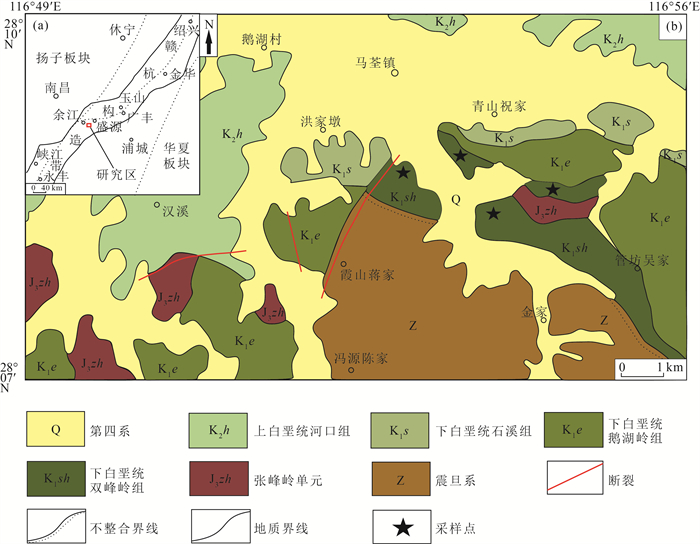
 下载:
下载:
